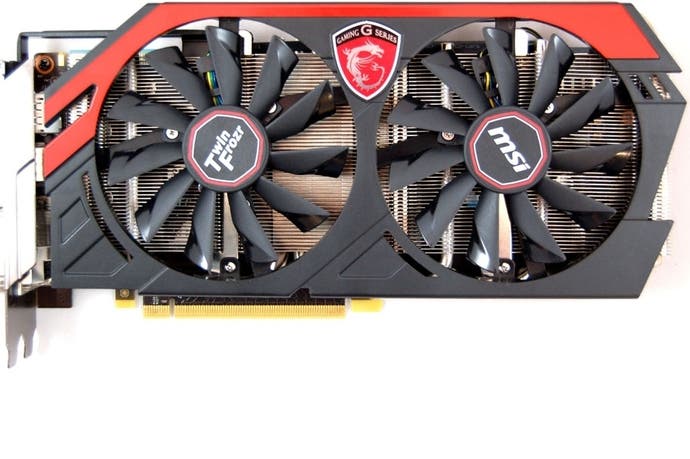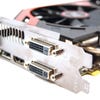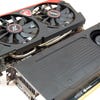Nvidia GeForce GTX 760 review
The price is right.
In our review of the GeForce GTX 770 we noted that Nvidia's second-generation "Kepler" graphics cards were all about boosting performance while increasing value - a noble sentiment for sure, but with a sticker price in the £300 region, that's still a hell of a lot of money to shell out for just one component of a gaming PC. The GTX 760, the latest addition to the product line-up, looks like a much more tempting proposition. Priced at £210/$250 (though expect the odd partner card at the £200 level), it offers most of the performance of the more expensive GTX 670, and in the process puts the £240/$300 Radeon HD 7950 in a very difficult position. Could we have found a new enthusiasts' favourite?
Nvidia says that the GTX 760 is designed to replace the outgoing GTX 660 Ti, in itself a highly regarded piece of kit. Looking at the specs, the new card actually has fewer CUDA core units - 1152 vs. the 1344 found in the Ti (and indeed the GTX 670). The key difference is bandwidth: the constricted 192-bit memory bus of the Ti is given the boot in exchange for a full 256-bit interface, upping peak bandwidth from 144.2GB/s to 192.2GB/s. Base clock rises to 980MHz compared to the 660 Ti's 915MHz, while the auto-overclocking boost clock reaches 1033MHz (up from 980MHz). Additionally, the amount of ROPs rises from 24 to 32 - very useful for operating at higher resolutions. In essence then, Nvidia has traded cores for more speed and extra bandwidth, opening up the opportunity for more satisfying performance at display formats like 2560x1440.
But it's the comparison with the more powerful GTX 670 that is perhaps more intriguing - the new card may only have 85 per cent of the CUDA cores, but base clocks are around seven per cent faster, and GPU Boost 2.0 technology could well help even the odds. Bearing in mind the price difference between the two cards, the idea of getting something approaching GTX 670-level performance in the £200/$250 price-bracket is mouthwatering.
In reviewing the GTX 760, we actually find ourselves with two review subjects: we have the standard reference card from Nvidia while MSI offered up its Twin Frozr IV "N760TF 2GD5/OC" model. As you can see from the product gallery below, the difference is night and day - the MSI product features a massive heatsink cooled by two large fans, and we're promised "military grade" component quality too. It also ships with a mild overclock, taking us up to 1085MHz core, 1150MHz boost - thus taking performance even closer to the GTX 670 ideal. Acoustically, it's a massive leap over the reference card - it's very quiet indeed, and clearly more adept at handling the high temperatures that GPUs run at. Given that you're paying just £10 more for the MSI-customised version of the card, that's pretty good value.
It's pretty clear from the reference design that the lower models in the Nvidia line-up aren't going to receive the same kind of love as the more expensive cards. The metallic chassis and ultra-quiet cooler reserved for the GTX 770, GTX 780 and Titan remains the preserve of the high end, meaning that the GTX 760 is rather bog-standard by comparison - all plastic and noticeably louder. On the flipside, this does mean that Nvidia's partners will be able to provide some pretty compelling customised efforts, of which the MSI model is just one. The question is, beyond the aesthetics, what kind of performance can we extract from this mid-range second-gen Kepler, and just how much do you sacrifice in terms of pure performance over the more expensive offerings available from Nvidia and AMD?
We kick off with our flagship standard - Crysis 3. While its "very high" settings are off the table at 1080p and higher (unless you're happy with ballpark 30fps performance), moving down a notch to the "high" level still stresses a PC more than the vast majority of games out there at max settings, meaning that if the GTX 760 can acquit itself well with the Crytek showpiece, it should be more than capable of handling any game you have in your library. Here we engage v-sync and SMAA 2x, our anti-aliasing method of choice for this demanding title. We also compare performance head-to-head at two key resolutions: 1920x1080 (full HD standard 1080p in other words) and 2560x1440, the emerging new 2.5K standard for PC gameplay.
The results are pleasing - for the most part we stay well north of 50fps at 1080p resolution, while 2560x1440 (or 1440p if you will) sees performance mostly remain well north of 30fps. Retaining v-sync and introducing a frame-rate limit could produce some silky smooth results here, especially once Crytek's excellent motion blur techniques are factored in. We've also included a second, much shorter video, offering up a comparison of Crysis 3 running the exact same content on the GTX 670 as well as our recent Radeon HD 7950 review subject at both stock and overclocked settings (effectively giving us a spectrum of what you can expect from various HD 7950 models).
The results are especially interesting. The GTX 760 offers a small boost over the stock HD 7950, while the GTX 670 and the overclocked HD 7950 duke it out for top dog honours, but the major takeaway here is that the actual delta in performance between the subjects is rather low. Factor in how much additional cash is required to achieve that small extra boost and the main takeaway here is that there's clearly a law of diminishing returns kicking in the more money you end up paying. What would happen if you delved into Crysis 3's advanced graphics menus and adjusted a couple of the effects-specific settings downwards a notch, equalising performance? Would you notice the difference? It's food for thought. As it is, our HD 7950 at stock frequencies is outclassed by the cheaper GTX 760, while the GTX 670 is only really offering a 2-4fps advantage, yet costs £60 to £80 more.
"On the performance intensive Crysis 3 gameplay test, the GeForce GTX 760 remains within striking distance of much more expensive products."
Alternative comparison:
Some might say that our definition of gameplay conditions - specifically the utilisation of v-sync - could be something of a leveller (the GPU effectively stalls waiting for the beginning of the next vertical refresh before it renders the frame), and that the value of a graphics card is perhaps better illustrated through examination of top-end, unbounded performance. Additionally, this is only a test of a single game, where a range of titles best represents the product's capability across a range of titles.
So with all that in mind, let's take a look at the GTX 760 across a range of gaming benchmarks in comparison with a small selection of more expensive graphics cards. We're sticking with our standard tests for the more expensive cards, kicking off with an "everything maxed" approach to BioShock Infinite, Tomb Raider, Sleeping Dogs, Hitman: Absolution, Metro 2033 and Metro: Last Light running at 1080p resolution. The GTX 760 is actually represented twice here - first in its stock, reference form, and secondly via the custom MSI card, which arrives with a mild factory overclock - an additional 65MHz (count 'em) added to both base and boost clock.
Results place the GTX 760 as a quality performer for its price point. It comfortably beats our vanilla HD 7950 at the benchmarks which most accurately reflect gameplay - BioShock and Tomb Raider - and battles it very closely on the bandwidth-sucking monsters like Hitman: Absolution and the Metro games. We see a mild increase in performance on the MSI overclocked model, sometimes no difference and even the odd negative adjustment. In truth, benchmarking is an often imprecise science as you have no idea what the OS is up to any given point and how much CPU effort is being exerted on tasks that may be occurring in the background.
More positively, the comparisons with the GTX 670 reveal a very close match - indeed, it even moves ahead in a couple of tests. Perhaps it's another example of the margin of error in effect, but the fact that it's so close at all bearing in mind the price differential is very compelling for a product that's much cheaper. [Update: We've updated the table with results from our overclocked HD 7950. With ALUs running at 1020MHz, and RAM at 1370MHz it's faster than the stock speeds of the current Boost edition of the card, but it gives you some idea of the range of performance AMD's closest competitor has. Unfortunately we did not have a boost edition card available for testing.]
"The GTX 760 is either very close to, the same as, or better than the GTX 670 running identical tests on the exact same PC. Impressive."
| 1920x1080 | GTX 760 | GTX 760 OC | GTX 670 | GTX 770 | HD 7950 (non-boost) | HD 7950 (OC) |
|---|---|---|---|---|---|---|
| BioShock Infinite, DX11 Ultra DDOF | 65.9FPS | 67.4FPS | 69.7FPS | 77.3FPS | 58.6FPS | 66.6FPS |
| Tomb Raider, Ultra, FXAA | 76.8FPS | 79.5FPS | 78.7FPS | 94.2FPS | 75.3FPS | 87.6FPS |
| Metro 2033, Very High, 4x MSAA | 31.5FPS | 30.0FPS | 31.0FPS | 33.5FPS | 33.5FPS | 36.5FPS |
| Metro: Last Light, Very High, SSAA | 27.0FPS | 27.5FPS | 26.5FPS | 33.5FPS | 27.0FPS | 30.5FPS |
| Hitman: Absolution, Ultra, 8x MSAA | 31.0FPS | 29.8FPS | 31.4FPS | 33.7FPS | 32.4FPS | 36.7FPS |
| Sleeping Dogs, Extreme | 41.1FPS | 43.8FPS | 39.1FPS | 48.0FPS | 40.8FPS | 46.8FPS |
We also had a quick shot at overclocking the MSI card via its bundled Afterburner software - we were rock-solid stable at an additional 130MHz over the reference card, gleaning an extra frame or two on all benchmarks. Open up the taps on the power consumption limits and you should be good for a little more clock-speed on the CUDA cores, and a small boost to the memory speed too - but don't expect miracles here.
Next up, we re-run the tests, moving up to the increasingly popular 2560x1440 resolution. Nvidia's press material appears to position the GTX 760 as the ultimate price vs. performance product for the most popular gaming resolution - 1920x1080 or its 16:10 equivalent, 1920x1200 - but both the HD 7950 and the GTX 670 acquit themselves well here and as the GTX 760 restores the 256-bit GDDR5 memory bus, bandwidth certainly shouldn't be a problem. Recognising that ultimate settings isn't going to produce a great experience here, we move the quality dial down a notch, so ultra becomes very high, and very high becomes high and so forth.
What we see is a virtual re-run of the 1080p differentials, though the HD 7950 does close the gap in BioShock Infinite, moving ever-so slightly ahead in Sleeping Dogs, but the fact remains that we're just a couple of percentage points or thereabouts behind the GTX 670, even drawing level in certain cases. Hitman: Absolution sees the GTX 670 retaining a small advantage, while Sleeping Dogs sees the GTX 760 drawing ahead. Run both cards in identical PCs side by side and we'd warrant that nobody would be able to tell the difference. Even acoustically, the two reference design examples we had seemed very similar indeed, though the MSI version was almost silent by comparison - in itself perhaps worth the small additional premium over a card based on the standard design.
"Seemingly designed with top-end 1080p gaming in mind, the GTX 760's 256-bit bus ensures that there's plenty of bandwidth available for more demanding resolutions."
| 2560x1440 | GTX 760 | GTX 760 OC | GTX 670 | GTX 770 | HD 7950 (non-boost) | HD 7950 (OC) |
|---|---|---|---|---|---|---|
| BioShock Infinite, DX11 Very High | 60.0FPS | 61.6FPS | 62.9FPS | 74.7FPS | 59.9FPS | 68.4FPS |
| Tomb Raider, High, FXAA | 73.4FPS | 75.8FPS | 76.5FPS | 93.1FPS | 68.4FPS | 78.6FPS |
| Metro 2033, High, 4x MSAA | 24.5FPS | 24.5FPS | 24.0FPS | 26.5FPS | 26.5FPS | 28.0FPSFPS |
| Metro: Last Light, High, No SSAA | 34.5FPS | 34.5FPS | 34.0FPS | 43.0FPS | 35.4FPS | 40.0FPS |
| Hitman: Absolution, High, 8x MSAA/2x MSAA | 19.6FPS/ 37.9FPS | 19.9FPS/ 38.7FPS | 21.2FPS/ 40.3FPS | 22.8FPS/ 45.2FPS | 21.8FPS/ 40.3FPS | 25.6FPS/ 48.7FPS |
| Sleeping Dogs, High | 47.4FPS | 51.5FPS | 46.5FPS | 56.8FPS | 48.1FPS | 55.3FPS |
Nvidia GeForce GTX 760: the Digital Foundry verdict
Nvidia is being very aggressive with the rollout of its second-generation Keplers. The GTX 770 offers build quality and performance advantages over both the GTX 670 and the GTX 680, but at £330/$399 it clearly remains a premium product. The GTX 760 is different beast entirely - it punches above its weight in the price/performance departments, effectively offering a GTX 670 experience for GTX 660 Ti money. After working with the card for a few days, we were fully expecting a price point to compete with the vanilla HD 7950, but instead Nvidia has comprehensively beaten it.
Bearing in mind how closely both AMD and Nvidia tend to tie percentile increases in performance with their price points, this is a bold move that could redefine the mid-range £200/$250 GPU market. GTX 670 inventory should drop in price, the still-decent GTX 660 Ti more so, while immense pressure is placed on both the AMD HD 7950 and the cut-down version, the HD 7870 XT - both good cards, but suddenly looking rather expensive for what they offer at stock performance levels.
Factor in the options that Nvidia includes that AMD doesn't - such as more fully featured 3D support, adaptive v-sync, the GeForce experience auto-settings selector ,plus the introduction of new cool stuff like ShadowPlay (Nvidia's answer to the Game DVRs coming to next-gen console) in addition to the firm's day-one driver support for major games - and the overall package looks even more enticing. These aren't frivolous value-added extras, they're genuinely useful options. The only real negative point you can possibly level at the GTX 760 concerns the 2GB memory allocation - with the arrival of the new consoles, all bets are off on what the RAM requirement for next-gen titles will actually be, and how that will affect the PC versions.
Overall though, the GTX 760 is clearly a very strong product, offering bags of performance at a really competitive price that will drive down the cost of a range of GPUs from both AMD and Nvidia. What's not to like?









